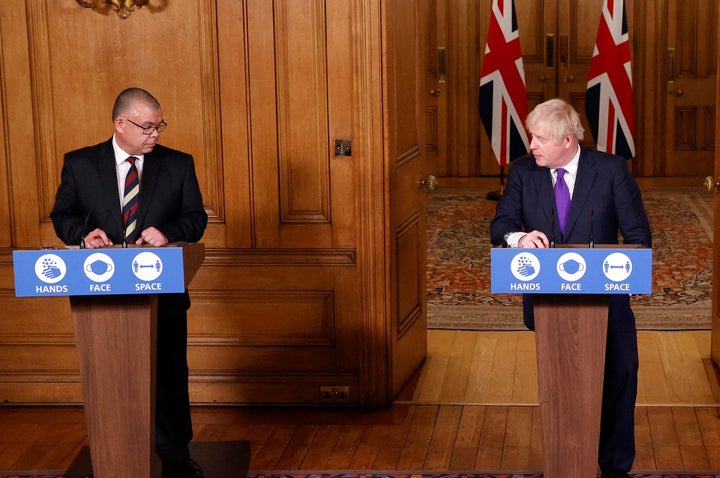
Ministers have been urged to ditch “extravagant word play” and use clearer language when tackling the virus as the government’s top scientific advisers raised concern over the emerging language of the pandemic.
The Covid-19 outbreak has spawned a vocabulary – from social distancing to the R rate – that was little known outside epidemiologists at the start of the year. World leaders and scientists have also opted for imaginative ways to articulate a new way of living as they’ve introduced authoritarian measures to curb the spread of coronavirus.
In the UK, Boris Johnson urged the public to help “squash the sombrero” and bring down the rise in infections, and England’s deputy chief medical officer professor Jonathan Van-Tam pleaded with people not to “tear the pants out of it” when lockdown restrictions were eased. Health secretary Matt Hancock is also prone to a rhetorical flourish, hailing the arrival of Covid-19 vaccines as a “candle of hope”.
On Friday, the Scientific Advisory Group for Emergencies (Sage) raised concern with the use of the new jargon. In its review of household transmission and ethnicity, Sage highlighted how describing a group of people allowed close physical contact as a “bubble” could be confusing for households where English isn’t the dominant language.
The consensus statement said: “Consideration should be given to ensuring that current social bubbles policy reflects the needs of minority ethnic groups living in larger multigenerational households; and also communicated in a meaningful way so that it is clear how it applies to their households (for example, the term ‘bubbles’ does not translate easily into non-English languages so alternative terms should be identified which will resonate).”
“Johnson and Hancock’s metaphors often come across as if they’re indulging in some extravagant word play just for the sake of it”
So is the UK government failing to communicate clearly enough with its mix of scientific language, metaphor and contradictory messages? As well as his fondness for referring to a “sombrero”, the prime minister alluded to “the drumming hooves of the cavalry coming over the brow of the hill” when ground-breaking vaccines emerged. Johnson was also this week urged by European Commission president Ursula von der Leyen to “keep distance” when struggling to abide by safety guidelines during Brexit talks.
Dr Philip Seargeant, a linguist and senior lecturer at the Open University, told HuffPost UK that there is a “tricky balance” to be struck between “the technical and the transparent”, and suggests ministers and scientists have to act as if they’re doctors talking to patients.
He said: “Basically you want to inform but not confuse, so sometimes it might be appropriate to sparingly introduce technical jargon – ‘flatten the curve’ was an earlier example – but at the same time ensure that the overall message and advice is clear and unambiguous.”
“Bubble” is more difficult because it’s a new idea which has been introduced specifically during the pandemic, and was not a particularly common concept before the regulations were introduced, said Seargeant.
“So its meaning isn’t really transparent to anyone, so needed to be defined. But certainly, making sure that the term – and the definition – works in other languages and for other cultures is vital,” he added. “The communications consultant Frank Luntz says that it’s not what you say but what people hear that’s important. And this definitely applies for scenarios such as public health advice.”
Some are better at the job than others. Van-Tam has won plaudits for his engaging metaphors – describing the progress of tackling the disease as if it was a football match, a plane landing and a train arriving at a station. Johnson, meanwhile, prefers the slightly more esoteric (“that toot of the bugle is louder, but it’s still some way off”.)
Seargeant, author of the book The Art of Political Storytelling, says: “Boris Johnson always seems to favour the exaggerated, over-the-top use of language, and while arguably it’s been quite successful in his political career as a whole, it’s not ideal for a situation like this. He’s often good at coming up with attention grabbing phrases, and vivid descriptions. And he often trades in a sort of mock-heroic hyperbole. But that’s not really what’s called for in a scenario like this.”
Van-Tam comes across as “more honest by not sugarcoating things” compared to Johnson’s “exaggerated optimism”. “There’s some striking and inventive imagery in the way Van-Tam speaks about the virus, but it all seems to be in the service of the overall message. Whereas Johnson and Hancock’s metaphors often come across as detached from the reality of things; as if they’re indulging in some extravagant word play just for the sake of it rather than to help convey the core message.”
So what should they be doing? Seargeant says “clarity, consistency, and honesty” are key. But another aim – cultivating trust – has been difficult to sustain throughout the pandemic. The academic points to Dominic Cummings’s notorious trip to Barnard Castle in April, which became a talking point again on Thursday night after justice secretary Robert Buckland admitted on Question Time that it was a “deeply unfortunate episode” that undermined the government’s coronavirus message.
Seargeant said: “The more the message changes, or comes across as incoherent, the less value people will place in it. Most people are aware that this is an unprecedented and constantly developing situation, and thus realise that advice will need to change and adapt – and so an honesty about these issues will add to the trustworthiness. And of course, any message is only as good as the effect it has.”
